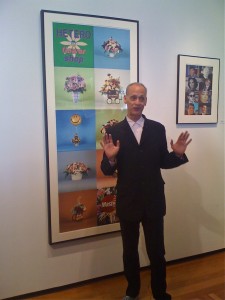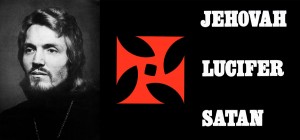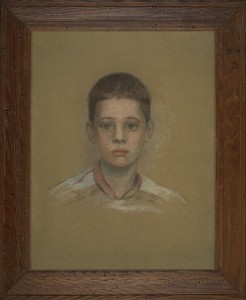While filmmaker/writer/artist John Waters conducted a walk-through of his current show, “Catholic Sin,” at Arthur Roger Gallery on Saturday afternoon, I thought about Nathanael West’s The Day of the Locust. The novel looks at the sad lives of Hollywood’s also-rans and peripheral players, but they’re nothing compared to the people who watch the movies:
They were savage and bitter, especially the middle-aged and the old, and had been made so by boredom and disappointment. All their lives they had slaved at some kind of dull, heavy labor, behind desks and counters, in the fields and at tedious machines of all sorts, saving their pennies and dreaming of the leisure that would be theirs when they had enough. Finally that day came. They could draw a weekly income of ten or fifteen dollars. Where else should they go but California, the land of sunshine and oranges?
Once there, they discover that sunshine isn’t enough. They get tired of oranges, even of avocado pears and passion fruit. Nothing happens. They don’t know what to do with their time. They haven’t the mental equipment for leisure, the money nor the physical equipment for pleasure. Did they slave so long just to go to an occasional Iowa picnic? What else is there? They watch the waves come in at Venice. There wasn’t any ocean where most of them came from, but after you’ve seen one wave, you’ve seen them all. The same is true of the airplanes at Glendale. If only a plane would crash once in a while so that they could watch the passengers being consumed in a “holocaust of flame,” as the newspapers put it. But the planes never crash.
 Their boredom becomes more and more terrible. They realize that they’ve been tricked and burn with resentment. Every day of their lives they read the newspapers and went to the movies. Both fed them on lynchings, murder, sex crimes, explosions, wrecks, love nests, fires, miracles, revolutions, war. This daily diet made sophisticates of them. The sun is a joke. Oranges can’t titillate their jaded palates. Nothing can ever be violent enough to make taut their slack minds and bodies. They have been cheated and betrayed. They have slaved and saved for nothing.
Their boredom becomes more and more terrible. They realize that they’ve been tricked and burn with resentment. Every day of their lives they read the newspapers and went to the movies. Both fed them on lynchings, murder, sex crimes, explosions, wrecks, love nests, fires, miracles, revolutions, war. This daily diet made sophisticates of them. The sun is a joke. Oranges can’t titillate their jaded palates. Nothing can ever be violent enough to make taut their slack minds and bodies. They have been cheated and betrayed. They have slaved and saved for nothing.
When one of the characters dies, there are members of the general public present at the funeral:
While not torch-bearers themselves, they would run behind the fire and do a great deal of the shouting. They had come to see Harry buried, hoping for a dramatic incident of some sort, hoping at least for one of the mourners to be led weeping hysterically from the chapel. It seemed to Tod that they stared back at him with an expression of vicious, acrid boredom that trembled on the edge of violence. When they began to mutter among themselves, he half-turned and watched them out of the corner of his eyes.
Strong stuff for 1939, and brutal critique of the marketing of the American Dream. When genuine pleasures no longer satisfy – or don’t satisfy in the way were feel we were promised – we settle for distractions such as Dancing with the Stars, where good dancing and lead-footed hobbling are equally desirable. The difference between Charlie Sheen: Comic Actor and Charlie Sheen: Human Grease Fire is irrelevant. One supermarket tabloid has photos from Kim Kardashian’s wedding while another shows stars rolling in their pre-lipo girth.
John Waters has made a career of interrogating celebrity in America. He has figured out how to do it in books, through public speaking, in his movies and now fine art. In his career-defining movies, he (like Andy Warhol) confronted Hollywood’s meritocracy and offered up his own troupe of actors. He not only declared them to be celebrities but successfully made Divine one. When he first reached outside of his stable of players for his movies, he chose former teen idols Tab Hunter (Polyester), post- 21 Jump Street Johnny Depp (Cry Baby), musician Iggy Pop (Cry Baby) and heiress/bank robber Patty Hearst (Serial Mom).
He considers himself a writer first, and explained that his visual art pieces start with some kind of writing; in the show, he literalizes a number of film terms in manipulated photos. “Rear Projections” – the name for the technique of projecting a movie of a background behind actors to create the illusion that they’re on location – includes stills of asses projected behind actors and stills of movies projected on people’s asses. “Product Placement” includes famous movie movements with Coca-Cola and other similar products inserted into the scenes.
The mixed emotions that West describes are on display in Waters’ work. His love of Hollywood is in every piece, but he can’t help but envision it degraded. In one piece, he has stills from famous movies, over which he superimposed subtitles of the famous text in Pig Latin. Beneath a close-up of Orson Welles from Citizen Kane is the caption, “Osebud-Ray.” In “Hollywood Smile Train,” he altered photos of stars including Tom Cruise to give them cleft palates. I wasn’t familiar with Smile Train or its commercials before Waters’ talk – it’s a non-profit that helps children with cleft palates – but he explained that he thought the kids in the commercials were celebrities in their own right.
Waters’ collected work proposes an inclusive notion of celebrity, one that includes him and – by extension – could include any of us. The pro and con of that stance is that the stakes are lowered from those West describes. He’s more likely to attack the beautiful people with pies instead of rocks and sticks, which makes his show kind, even as it mocks celebrity culture – but that also makes the pieces little more than well-crafted witticisms. It’s bitchily funny to see Tara Reid’s face projected on to someone’s naked rear, or the interior designer-sized roach motel, but the pieces are easily and fairly quickly consumed. It’s hard to imagine that many of these pieces will continue to speak to viewers once their initial point is made. I love the framed empty pads of paper as the physical representation of finished writing, but the three-by-three grid of pads with all the pages ripped out will never say more than what it said when Waters explained it.
The strongest pieces in “Catholic Sin” were less jokey. “Stalker” is a collection of Post-It Notes with instructions for what people at book signings wanted Waters to write in their books. Even if some are faked as he said in the walk-through, many are disturbing as they represent fans trying to meet him on what they think is his level. It’s also not clear how we’re to take his portrait of Robert DeGrimston of the Process Church along side the church’s symbol and the names Jehovah, Lucifer and Satan. At the walk-through, Waters pointed out that there used to be a Process Church on Ursulines Street, and later that night he showed me that he was wearing a Process Church ring, but the piece had an appealing ambiguity. DeGrimston and the symbol gave the piece the look of ’70s biker movie poster, with Jehovah and Lucifer adding spiritual consequences and possibly scares. It’s not something that would be a clever conversation piece were it to find its way into your art collection; DeGrimston’s cut cheekbones and hard eyes ensure that the piece would hang uneasily on almost any way.
“John Jr.” seems like a joke at first – a Jackson Square pastel portrait of Waters around 10 to 12 years old with a pencil-thin mustache added – but like “The Process,” it’s one where the visual matter counts. It’s hard not to look at the wide-eyed and blank child and wonder what he’s thinking. Is he deadened by his life so far? Bored by the portrait process, or something larger? If he knew what his life had in store for him, would he make the same choices? I thought about a similar portrait of me with my brothers and sister that my mom had done for dad as a birthday present, and how it captured the four of us in an image that looks like us without feeling like us.
In those pieces, Waters’ relationship to celebrity becomes more complicated and the work is more rewarding. In them, he steps away from his chosen role as barker for the American Pop Culture Sideshow – selling a look at the freaks while he’s in business with them – and in “John Jr.” particularly, pulls the curtain aside to reveal some real humanity.






